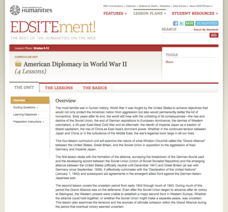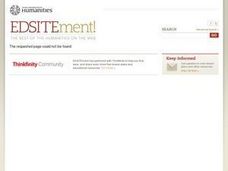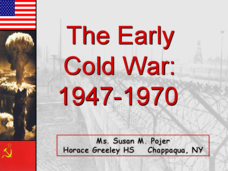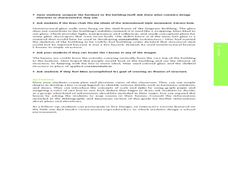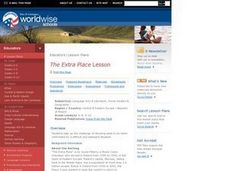Curated OER
Do the Research! Berlin Wall Between East and West Germany
In this Berlin Wall worksheet, students do research to find information about the wall built to separate East and West Germany. Using that information, students answer 4 short essay questions.
Curated OER
Why is the Middle East so Stereotyped in the West?
High schoolers examine the stereotypes used to classify the Middle East. After taking a regional literacy survey, they discover their own global awareness. They discuss how stereotypes are formed and how they persist over time if not...
Curated OER
The Flag of Germany
In this flag of Germany worksheet, students read the history of the flag and directions to coloring it. Students color 1 flag and use 3 colors.
Curated OER
Perceptions of German Unification Over Time
Through a series of readings and handouts, learners will study the shifts in perception that followed the fall of the Berlin Wall. The history instructional activity focuses on periods of change in post WWII German history that led to a...
Curated OER
The Cold War: Chapter 9: Lesson 1
Used as a quick review of the Cold War, Korean War, and Cuban Missile Crisis, this presentation could be in many scenarios. However, the graphics and question types seem more appropriate for younger students, while the content is geared...
Curated OER
7th Grade German
Each of these slides has clear images, text, and short summaries which will introduce basic facts about Germany to your students. There are photographs to accompany facts about important events in World War I and II, and also some...
Curated OER
Has the Wall Truly Tumbled Down?
Students examine the events behind the destruction of the Berlin Wall and the continued struggles to truly unify the former East Germany and West Germany.
Curated OER
The Berlin Wall
Students enter the classroom and observe a wall that is set up with desks, bookshelves, or anything else available. to create a barrier that they cannot cross during the class. The class then is divided into East and West Berlin with the...
Mrs. Robbins' Social Studies Site
The Berlin Blockade
The Berlin Blockade may not take up as much space in the history books as other events of the Cold War, but for the citizens of west Berlin in 1948—and the events to follow between the Soviet Union and the United Stattes—those 318 days...
Student Handouts
End to the Cold War
Introduce your class to topics relating to the Cold War through a brief reading selection. Class members read the passage and answer four questions, which are provided on the bottom of the page.
Curated OER
Locations Of Countries In Europe
In this European geography worksheet, students describe where 12 countries in Europe are located by using directional phrases. Students also practice describing the nationalities of people from each country and how to pronounce each...
National Endowment for the Humanities
American Diplocmacy in World War II
The end of World War II saw the world deeply changed over the last few years. Four thorough lessons explore post-war Europe, America, and Asia through reading assignments and discussion questions about the Grand Alliance and the signing...
Curated OER
How Has Colonialism Led to Multilingualism in Africa
Prepare yourself for a top-notch presentation on colonialism in Africa! Discussed are the reasons for African multilingualism. Maps and a country-by-country look at various colonists that made their mark on the African continent are...
Smithsonian Institution
Cold War
The Cold War was not necessarily always cold in temperature, but the relationship between the United States and the Soviet Union sure was frigid! Scholars read various passages, view exhibition graphics, and observe an artifact from the...
Curated OER
Berlin Wall Lesson Plans
Berlin Wall lesson plans can teach students how this barrier divided a country and why it gained so much international attention.
National Endowment for the Humanities
How "Grand" and "Allied" Was the Grand Alliance?
Learn more about the Grand Alliance with a scaffolded lesson plan that includes four activities. Class members use primary sources to complete a map exercise, understand the goals and objectives of each individual nation, and participate...
Curated OER
Victory in Europe, 1944-1945
Students examine the overall strategy pursued by the Allies in the final moths of World War II in Europe by examining military documents and consulting an interactive map of the European theater.
Curated OER
Time Zone Math
In this algebra worksheet, students calculate the different time of the day that different countries see the sun. They convert between different time zones. There are 3 questions with an answer key.
Curated OER
The Treaty of Versailles: June 1919
There were four key players involved with the Treaty of Versailles. Present information and critical thinking questions regarding Woodrow Wilson, David Lloyd-George, Georges Clemenceau, and Vittorio Orlando. Included also are lists of...
Curated OER
The Early Cold War: 1947-1970
With a combination of images, maps, and valuable information, this presentation is a strong resource for a history class that is coming out of a WWII unit and into a Cold War unit. Some points are outlined for students, while others are...
Curated OER
Fill-In - October Event in History
A lot has happened in the month of October in the past 100 years or so. Kids fill in the blank for 31 events, each of which occurred on a day in October. Each event can be found in a New York Times article from the past 100+ years....
Scholastic
Groundhog Day
A simple activity for a simple, but special, holiday. Young learners read a brief history of Groundhog Day, practice reading aloud, and then discuss how shadows are formed.
Curated OER
Exploring the Design Process
Students analyze the design process and architecture of Ludwig van der Rohe. In this architecture and art analysis lesson, students explore the design process through photographic documentation and architectural plans. Students use...
Curated OER
The Extra Place
Students read and discuss the story of a Peace Corps volunteer's experiences in Poland. They read and write a response to the story, and participate in a class analysis about their own personal decision regarding the story.













